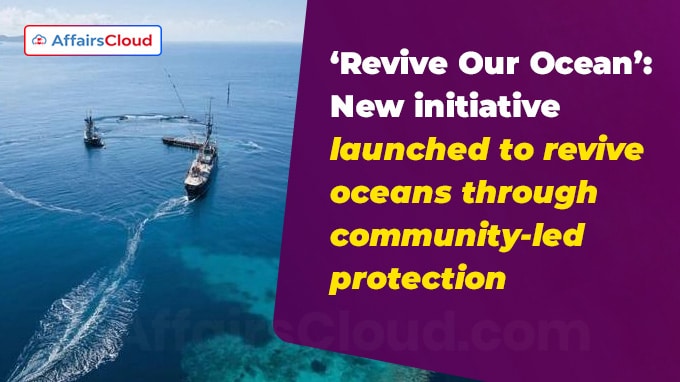 In April 2025, a new global initiative called ‘Revive Our Ocean’, first-of-its-kind programme was launched to empower coastal communities in establishing and managing Marine Protected Areas (MPAs) through localized action. This initiative is being led by the United States of America (USA)- based Non-Governmental Organization(NGO) Dynamic Planet along with the National Geographic Society (NGS)’s Pristine Seas programme.
In April 2025, a new global initiative called ‘Revive Our Ocean’, first-of-its-kind programme was launched to empower coastal communities in establishing and managing Marine Protected Areas (MPAs) through localized action. This initiative is being led by the United States of America (USA)- based Non-Governmental Organization(NGO) Dynamic Planet along with the National Geographic Society (NGS)’s Pristine Seas programme.
- A new initiative is supported by the renowned British naturalist David Attenborough. It is built on three main pillars: Inspire, Enable, and Equip.
About Revive Our Ocean Initiative:
i.The main goal of this initiative is to help coastal communities create and manage MPAs by removing the barriers they face.
ii.Three main barriers has been pointed out by the team behind Revive Our Ocean:
- National laws that limit local communities from setting up MPAs,
- Lack of awareness about the benefits of MPAs,
- Lack of tools, knowledge, and financial support to manage MPAs properly.
iii.Revive Our Ocean has created the Revive Our Ocean Collective, bringing together local leaders and successful community groups, under the leadership of Kristin Rechberger, Chief Executive Officer (CEO) of Dynamic Planet, and Enric Sala, marine ecologist and founder of National Geographic Pristine Seas.
- At first, it will focus on seven countries: the United Kingdom (UK), Portugal, Greece, Turkey, the Philippines, Indonesia, and Mexico.
iv.It also plans to launch a microfinance program, offering small loans and grants to help communities start or expand their marine protected areas.One of the biggest aims of this initiative is to end destructive fishing practices like bottom trawling.
About Marine Protected Areas (MPAs):
i.MPAs are sections of the ocean reserved to protect marine life and habitats, managed by governments, local authorities, NGOs, or communities.
ii.The 30X30 target of the Kunming-Montreal Global Biodiversity Framework (KMGBF), adopted during the 15th Conference of the Parties to the Convention on Biological Diversity (COP15) in 2022 to protect 30% of the oceans by 2030.
iii.According to the Protected Planet Report 2024, over 16,000 MPAs have been established worldwide, covering approximately 8% of the global ocean and just 3% have full protection.
ii.Research shows that bottom trawling causes USD 12.54 billion (Euro11 billion) loss every year in Europe by damaging the ocean floor and releasing carbon.
Note: India has designated a total of 31 major Marine Protected Areas (MPAs) along its coastline, all of which are notified under the Wildlife (Protection) Act, 1972.
Community-led MPAs:
Community-led MPAs have shown impressive results in different parts of the world:
i.In Spain, the no-fishing zone around Medes Island generates USD 18.24 million (Euro 16 million) annually from diving tourism, 25 times more than fishing; on Scotland’s Isle of Arran, marine life on the seabed doubled after a no-fishing zone was created.
ii.In the Philippines, RARE’s Fish Forever program helped over 2,000 communities set up no-fishing zones, doubling fish populations in just five year.
About National Geographic Society (NGS):
Chief Executive Officer (CEO)– Dr. Jill Tiefenthaler
Established– 1888
Headquarters- Washington, the United States of America (USA)




